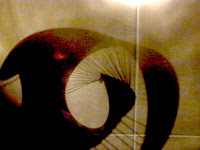As development on my research about minimal artists and visiting the Do It exhibition, this week I decided to do a few tests using the idea behind a lot of Sol LeWitt's work: instructions.
For the first experiment I used 7 people including myself, and gave them the following instructions (an adaptation of Sol LeWitts instructions for drawing #118):
On a paper surface,
Any size, shape or colour paper surface,
Using a hard pencil,
place 20 points at random,
But these points must be evenly distributed over the surface.
All of the points should be connected by straight lines.
I hadn't seen the result of the drawing by the gallery before I did my experiment, but it is shown below.
The results were really interesting, as only one looked like the result above, which is shown below..
Here are a few of the other results, which had very different qualities, some were joined like a dot to dot, and some lines connected just 2 dots.
After doing this experiment, I wanted to do another one but creating my own instructions to control the results a little bit more. They are shown below.
On a blank piece of paper, draw a square, 10cm by 10cm.
Draw a grid inside this of 25 squares, each 2cm by 2cm.
Fill each square with various lines, of any kind.
Here are some of my favourite results, because of tone and line quality.
As development from this, I need to decide what I am going to take from my findings, which might mean that I do more experiments or use the results I have to make more work and drawings.



























g.jpg)
g.jpg)




















